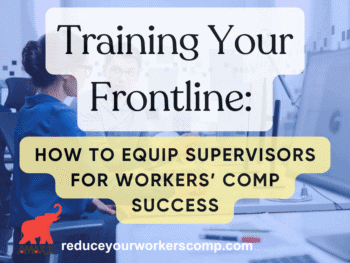The vast majority of injured employees want to recover and return to work (and life as usual) as quickly as possible. Giving them a little attention and providing information may make all the difference in avoiding a costly litigated claim.
1. Set your employees’ expectations by explaining the workers’ compensation process including the claim investigation, the persons involved and their rolls (adjuster, physician, nurse case manager, company contact, etc.) and provide a broad benefit overview.
2. Prepare a pamphlet to hand out upon injury covering what you’ve explained so injured workers have something to refer to. Include the adjusters name and telephone number and the company contact name and phone number.
3. Explain your return-to-work program including the progression of returning to modified work and transitioning back to full, pre-injury duties with timeframes to the extent possible based on the injury. Help keep the injured worker focused on healing and returning to work.
4. Let injured employees know they remain a valuable member of your workforce and an asset to the company. Send a get well card signed by their immediate supervisor and other managers as appropriate in cases of compensable lost time.
5. Keep in touch with injured workers losing time from work to the extent possible. Even in the event of attorney representation, learn from your own defense counsel what legally can and cannot be discussed in your jurisdiction and have a weekly conversation with injured workers. How are they recovering? Do they feel they’re making progress and are they satisfied with their treatment? Is there anything they need? Are they receiving their indemnity benefits? Do they have any questions?
6. Invite injured workers losing time from work to participate in extracurricular employment related activities such as holiday gatherings.
7. Arrange to see injured employees who are losing time from work once a week, or as allowed in your jurisdiction by asking him or her to bring a current work ability form from the most recent medical appointment.
8. Confirm the injured employee has a company contact for questions related to FMLA and possibly the ADA and is informed as to the status of each as indicated.
9. Encourage employees to keep licenses or other employment designations current to the extent possible such as DOT physicals for a CDL or state licenses for trade-type employment.
10. Maintain open lines of communication and be sure your employee is informed as to the ongoing status of his or her claim to prevent surprises. Avoiding unwelcome surprises can reduce litigation and ultimately, costs. (workersxzcompxzkit)
Application of these 10 simple steps helps reduce costs and litigation and your only cost is a little time. That’s quite return on investment and well worth the effort.
Author Robert Elliott, executive vice president, Amaxx Risks Solutions, Inc. has worked successfully for 20 years with many industries to reduce Workers’ Compensation costs, including airlines, health care, manufacturing, printing/publishing, pharmaceuticals, retail, hospitality and manufacturing. He can be contacted at: Robert_Elliott@ReduceYourWorkersComp.com or 860-553-6604.
“FRAUD PREVENTION” PODCAST click here: http://www.workerscompkit.com/gallagher/mp3
By: Private investigator with 25 years experience.
TD Calculator: www.ReduceYourWorkersComp.com/transitional-duty-cost-calculator.php
WC Calculator: http://www.reduceyourworkerscomp.com/calculator.php
Do not use this information without independent verification. All state laws vary. You should consult with your insurance broker or agent about workers’ comp issues.
©2009 Amaxx Risk Solutions, Inc. All rights reserved under International Copyright Law. If you would like permission to reprint this material, contact Info@WorkersCompKit.com

















